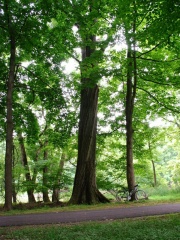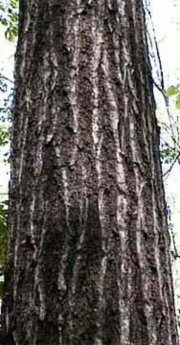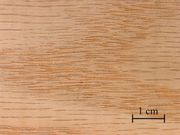Difference between revisions of "Northern red oak"
Jump to navigation
Jump to search
m (Text replace - "== Authority ==" to "== Sources Checked for Data in Record ==") |
|||
| (One intermediate revision by the same user not shown) | |||
| Line 1: | Line 1: | ||
| − | [[File:RedOaktreef5.jpg|thumb|Northern red oak | + | [[File:RedOaktreef5.jpg|thumb|Northern red oak ''Quercus rubra'']] |
| − | |||
| − | ''Quercus rubra'']] | ||
== Description == | == Description == | ||
| − | + | [[File:qrubrabark.jpg|thumb|Northern red oak ''Quercus rubra'']] | |
A large oak, Quercus rubra (syn ''Quercus borealis)'', native to North America, growing from Kansas northwards to Canada and from the Great Lakes west to the Pacific Ocean. The northern red oak produces a hard, strong timber that has a pale reddish brown color. It is used for furniture, flooring, veneers, shipbuilding, railroad ties, and interior trim. | A large oak, Quercus rubra (syn ''Quercus borealis)'', native to North America, growing from Kansas northwards to Canada and from the Great Lakes west to the Pacific Ocean. The northern red oak produces a hard, strong timber that has a pale reddish brown color. It is used for furniture, flooring, veneers, shipbuilding, railroad ties, and interior trim. | ||
| Line 9: | Line 7: | ||
Appalachian red oak; ''Quercus rubra; Quercus borealis''; Rød-Eg (Dan.); Roteiche (Deut.); chêne rouge d'Amérique (Fr.); Amerikaanse eik (Ned.); roble americano (Esp.); carvalho vermelho americano (Port.) | Appalachian red oak; ''Quercus rubra; Quercus borealis''; Rød-Eg (Dan.); Roteiche (Deut.); chêne rouge d'Amérique (Fr.); Amerikaanse eik (Ned.); roble americano (Esp.); carvalho vermelho americano (Port.) | ||
| + | [[File:40_Appal.RedOak.jpg|thumb|Appalachian Red Oak (''Quercus borealis'')]] | ||
| + | == Physical and Chemical Properties == | ||
| − | + | * Tree grows to 35 m with straight trunk and round crown | |
| − | + | * Leaves = oblong with 7 to 11 bristle-tipped lobes | |
| − | + | * Fruit = round acorn with flat, thick cap, matures in two years in late summer. | |
| − | + | * Density = 44 pcf | |
| − | + | * Heartwood is light to medium brown | |
| − | Tree grows to 35 m with straight trunk and round crown | + | * Sapwood is lighter but not clearly demarcated |
| − | + | * Grain is straight with a coarse uneven texture | |
| − | + | * Wood is susceptible to decay and insects | |
| − | |||
| − | |||
| − | |||
| − | |||
| − | |||
| − | |||
| − | |||
| − | |||
| − | |||
| − | |||
| + | ==Working Properties== | ||
| + | * Produces good results with hand and machine tools. | ||
| + | * Has moderately high shrinkage values, resulting in mediocre dimensional stability, especially in flatsawn boards. | ||
| + | * Can react with iron (particularly when wet) and cause staining and discoloration. | ||
| + | * Responds well to steam-bending. | ||
| + | * Glues, stains, and finishes well. | ||
| − | == | + | ==Resources and Citations== |
| + | * The Wood Database: [https://www.wood-database.com/red-oak/ Red Oak] | ||
* G.S.Brady, ''Materials Handbook'', McGraw-Hill Book Co., New York, 1971 Comment: p. 555 | * G.S.Brady, ''Materials Handbook'', McGraw-Hill Book Co., New York, 1971 Comment: p. 555 | ||
| Line 36: | Line 33: | ||
* ''Dictionary of Building Preservation'', Ward Bucher, ed., John Wiley & Sons, Inc., New York City, 1996 | * ''Dictionary of Building Preservation'', Ward Bucher, ed., John Wiley & Sons, Inc., New York City, 1996 | ||
| − | * | + | * Hardwood Manufacturers Institute, Memphis Tenn.: air-dry weight = 44 pcf |
| − | * | + | * Virginia Tech Dendrology website at www.fw.vt.edu/dendro/dendrology/main.htm (accessed Oct. 8, 2005) |
| − | * Wikipedia | + | * Wikipedia: http://en.wikipedia.org/wiki/Quercus_borealis (Accessed Oct. 8, 2005) |
[[Category:Materials database]] | [[Category:Materials database]] | ||
Latest revision as of 12:23, 19 October 2022
Description
A large oak, Quercus rubra (syn Quercus borealis), native to North America, growing from Kansas northwards to Canada and from the Great Lakes west to the Pacific Ocean. The northern red oak produces a hard, strong timber that has a pale reddish brown color. It is used for furniture, flooring, veneers, shipbuilding, railroad ties, and interior trim.
Synonyms and Related Terms
Appalachian red oak; Quercus rubra; Quercus borealis; Rød-Eg (Dan.); Roteiche (Deut.); chêne rouge d'Amérique (Fr.); Amerikaanse eik (Ned.); roble americano (Esp.); carvalho vermelho americano (Port.)
Physical and Chemical Properties
- Tree grows to 35 m with straight trunk and round crown
- Leaves = oblong with 7 to 11 bristle-tipped lobes
- Fruit = round acorn with flat, thick cap, matures in two years in late summer.
- Density = 44 pcf
- Heartwood is light to medium brown
- Sapwood is lighter but not clearly demarcated
- Grain is straight with a coarse uneven texture
- Wood is susceptible to decay and insects
Working Properties
- Produces good results with hand and machine tools.
- Has moderately high shrinkage values, resulting in mediocre dimensional stability, especially in flatsawn boards.
- Can react with iron (particularly when wet) and cause staining and discoloration.
- Responds well to steam-bending.
- Glues, stains, and finishes well.
Resources and Citations
- The Wood Database: Red Oak
- G.S.Brady, Materials Handbook, McGraw-Hill Book Co., New York, 1971 Comment: p. 555
- Dictionary of Building Preservation, Ward Bucher, ed., John Wiley & Sons, Inc., New York City, 1996
- Hardwood Manufacturers Institute, Memphis Tenn.: air-dry weight = 44 pcf
- Virginia Tech Dendrology website at www.fw.vt.edu/dendro/dendrology/main.htm (accessed Oct. 8, 2005)
- Wikipedia: http://en.wikipedia.org/wiki/Quercus_borealis (Accessed Oct. 8, 2005)


